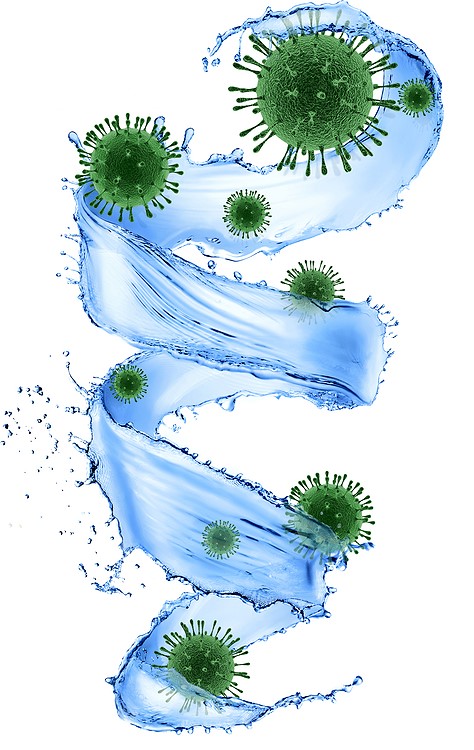Part of a special series: Water & the Virus
Take a drop of water from a river or lake, concentrate the particles in the water on a very fine filter, add preservatives and stains for living material, place the filter on a microscope slide and examine. The vital stains will fluoresce when light of a specific wave band (e.g., blue light) is applied. At high magnification, you will see hundreds of bacteria and thousands of tiny, tiny viruses in your field of view. These viruses are in their so-called “free-living” stage. I tell my students in limnology (the study of freshwaters) to think of viruses as a syringe needle with the nucleic acids—DNA or RNA—inside. The needle injects the nucleic acid into cells. The DNA or RNA then takes over the cell machinery and replicates itself, forming new viruses. These nascent viruses become so numerous that they burst the cell, whereupon the viruses are released to infect other cells—that’s an outbreak at the cellular level.
The free-living viruses in view in our microscope are, at the moment, not infecting cells, but rather at the dispersal stage, seeking a cell. Free-living viruses found in water are mainly bacteriophages, which means they specifically infect bacterial cells. These infections are a major mechanism of bacterial mortality in nature. Other viruses cause fish disease. Even others are human pathogens, but these viruses won’t live long freely floating around in freshwater environments. They are killed by ultraviolet light and eaten by predatory microbes. Thus, like other living entities, individual viruses undergo a life cycle that, in their case, involves infection, reproduction, dispersal, and eventually death.
The world is full of viruses. They are especially numerous in fresh water and the ocean. Most are harmless to people, but all viruses infect other organisms, and viral invasions are an ongoing phenomena. A good example is VHS, which stands for viral hemorrhagic septicemia. VHS is a fish disease caused by a virus. The disease has long been known in Europe but was first detected in the United States in 1988. It subsequently swept through natural fish populations, leading to large die-offs. This is likely a case of a disease that was somehow transported from fish-culturing facilities in Europe to North America and then spread into natural systems. The overall impact of the disease on freshwater fish populations is largely unknown, aside from the above-mentioned large mortality events. VHS, however, is emblematic of how new viral diseases emerge, spread, and cause harm to their target hosts.
Human viral diseases can be contracted in water, but SARS-coronavirus-2 (the organism), which we are all so concerned about, is not transmitted that way. There is extremely low risk (never say “never”) of getting COVID-19 (the disease) while swimming. Why? First, the virus will not survive long in its free-living state in natural waters. Second, treatment that disinfects the water we drink and the sewage we produce kills most pathogens. Third, COVID-19 is transmitted mainly by exposure to respiratory droplets of infected humans. Thus, disease spread is not a consequence of contaminated water supplies or water bodies.
Despite the lack of spread by water, scientists can measure the presence of SARS-coronavirus-2 by sampling the wastewater in treatment plants. Gene products of the virus are amplified and detected by special methods. The analysis of wastewater samples can give an idea of the presence, and possibly the abundance in the human population, in an area served by a sewage system. This might be a clever way to do surveillance without having to sample lots of people. This type of information is not an answer to controlling the disease, however, because that requires identifying infected individuals and isolating them. Sampling sewage will help identify locations and populations where the disease is active or inactive. This might be helpful to the public health authorities especially in the long run, as we learn to live with and manage the disease.
SARS-coronavirus-2 is almost certainly a spillover from one species (likely bats) to another species (humans). This species jump has ramified throughout the world. Detection of the virus in individuals, populations, and communities is needed. Human sewage systems are going to be monitored for these viruses, and this will be one helpful source of information. Despite the presence of SARS-coronavirus-2 in our waters, we are not threatened there because these waters are not the ecological domain of this particular virus. You should feel comfortable swimming—socially distanced from other humans, who are your real source of worry.
Mike Pace is a Professor of Environmental Science at the University of Virginia and the President of the Association for the Sciences of Limnology and Oceanography.



